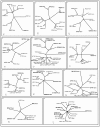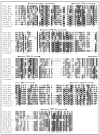Cross genome phylogenetic analysis of human and Drosophila G protein-coupled receptors: application to functional annotation of orphan receptors
- PMID: 16091152
- PMCID: PMC1192796
- DOI: 10.1186/1471-2164-6-106
Cross genome phylogenetic analysis of human and Drosophila G protein-coupled receptors: application to functional annotation of orphan receptors
Abstract
Background: The cell-membrane G-protein coupled receptors (GPCRs) are one of the largest known superfamilies and are the main focus of intense pharmaceutical research due to their key role in cell physiology and disease. A large number of putative GPCRs are 'orphans' with no identified natural ligands. The first step in understanding the function of orphan GPCRs is to identify their ligands. Phylogenetic clustering methods were used to elucidate the chemical nature of receptor ligands, which led to the identification of natural ligands for many orphan receptors. We have clustered human and Drosophila receptors with known ligands and orphans through cross genome phylogenetic analysis and hypothesized higher relationship of co-clustered members that would ease ligand identification, as related receptors share ligands with similar structure or class.
Results: Cross-genome phylogenetic analyses were performed to identify eight major groups of GPCRs dividing them into 32 clusters of 371 human and 113 Drosophila proteins (excluding olfactory, taste and gustatory receptors) and reveal unexpected levels of evolutionary conservation across human and Drosophila GPCRs. We also observe that members of human chemokine receptors, involved in immune response, and most of nucleotide-lipid receptors (except opsins) do not have counterparts in Drosophila. Similarly, a group of Drosophila GPCRs (methuselah receptors), associated in aging, is not present in humans.
Conclusion: Our analysis suggests ligand class association to 52 unknown Drosophila receptors and 95 unknown human GPCRs. A higher level of phylogenetic organization was revealed in which clusters with common domain architecture or cellular localization or ligand structure or chemistry or a shared function are evident across human and Drosophila genomes. Such analyses will prove valuable for identifying the natural ligands of Drosophila and human orphan receptors that can lead to a better understanding of physiological and pathological roles of these receptors.
Figures









Similar articles
-
Phylogenetic analysis of 277 human G-protein-coupled receptors as a tool for the prediction of orphan receptor ligands.Genome Biol. 2002 Oct 17;3(11):RESEARCH0063. doi: 10.1186/gb-2002-3-11-research0063. Epub 2002 Oct 17. Genome Biol. 2002. PMID: 12429062 Free PMC article.
-
Nematode and arthropod genomes provide new insights into the evolution of class 2 B1 GPCRs.PLoS One. 2014 Mar 20;9(3):e92220. doi: 10.1371/journal.pone.0092220. eCollection 2014. PLoS One. 2014. PMID: 24651821 Free PMC article.
-
A genome-wide inventory of neurohormone GPCRs in the red flour beetle Tribolium castaneum.Front Neuroendocrinol. 2008 Jan;29(1):142-65. doi: 10.1016/j.yfrne.2007.10.003. Epub 2007 Oct 24. Front Neuroendocrinol. 2008. PMID: 18054377 Review.
-
A review of neurohormone GPCRs present in the fruitfly Drosophila melanogaster and the honey bee Apis mellifera.Prog Neurobiol. 2006 Sep;80(1):1-19. doi: 10.1016/j.pneurobio.2006.07.005. Prog Neurobiol. 2006. PMID: 17070981 Review.
-
The identification of ligands at orphan G-protein coupled receptors.Annu Rev Pharmacol Toxicol. 2004;44:43-66. doi: 10.1146/annurev.pharmtox.44.101802.121419. Annu Rev Pharmacol Toxicol. 2004. PMID: 14744238 Review.
Cited by
-
Cross-Genome Clustering of Human and C. elegans G-Protein Coupled Receptors.Evol Bioinform Online. 2012;8:229-59. doi: 10.4137/EBO.S9405. Epub 2012 Jun 19. Evol Bioinform Online. 2012. PMID: 22807621 Free PMC article.
-
ADGRL4/ELTD1 is a highly conserved angiogenesis-associated orphan adhesion GPCR that emerged with the first vertebrates and comprises 3 evolutionary variants.BMC Evol Biol. 2019 Jul 12;19(1):143. doi: 10.1186/s12862-019-1445-9. BMC Evol Biol. 2019. PMID: 31299890 Free PMC article.
-
Genome-Wide Identification of G Protein-Coupled Receptors in Ciliated Eukaryotes.Int J Mol Sci. 2023 Feb 15;24(4):3869. doi: 10.3390/ijms24043869. Int J Mol Sci. 2023. PMID: 36835283 Free PMC article.
-
The chemokine MCP-1 (CCL2) in the host interaction with cancer: a foe or ally?Cell Mol Immunol. 2018 Apr;15(4):335-345. doi: 10.1038/cmi.2017.135. Epub 2018 Jan 29. Cell Mol Immunol. 2018. PMID: 29375123 Free PMC article. Review.
-
DOR - a Database of Olfactory Receptors - Integrated Repository for Sequence and Secondary Structural Information of Olfactory Receptors in Selected Eukaryotic Genomes.Bioinform Biol Insights. 2014 Jun 12;8:147-58. doi: 10.4137/BBI.S14858. eCollection 2014. Bioinform Biol Insights. 2014. PMID: 25002814 Free PMC article.
References
Publication types
MeSH terms
Substances
Grants and funding
LinkOut - more resources
Full Text Sources
Molecular Biology Databases

